-
Posts
2,616 -
Joined
-
Last visited
Content Type
Profiles
Forums
Store
Help Articles
Posts posted by Peter the eater
-
-
The 100 Mile Diet is a new book, a website and a bit of a grassroots movement which seems to be getting a lot of media attention. In a nutshell, the two authors from Vancouver decided to only eat food that comes from close to home. Here's the opening line from the Webpage:
When the average North American sits down to eat, each ingredient has typically travelled at least 1,500 miles—call it "the SUV diet. On the first day of spring, 2005, Alisa Smith and James MacKinnon chose to confront this unsettling statistic with a simple experiment. For one year, they would buy or gather their food and drink from within 100 miles of their apartment in Vancouver, British Columbia."
Pretty compelling if you ask me. What would your meal look like?
-
The earliest one I know of is 'De obseruatione ciborium ' (On the Observance of Foods) by a sixth century Byzantine Greek called Anthimus. A version of it has been published by Prospect Books - I lent mine out to I dont remember who or when, so I guess I'd better get myself another copy.
Thanks for your input - I am enjoying the tremendous content on your own site. The Online_Historic_Cookbooks3 will keep me busy for a while!
-
Must I cook noodles al dente?! No I say! I like my noodles silky, soft and otherwise welcoming but certainly not mushy and definitely exhibit no resistance.
I agree 100%.
Same goes for risotto - there are few things with worse mouth feel than under-cooked rice.
-
I think there are many "manifestos" on food, depending on what you wish to include in the term "manifesto". Looking at the term as meaning "a public declaration of purpose" by a person or a group, the inclusions could be quite extensive.
You are quite right, "manifesto" seems like such a political word to me. A treatise or a policy or accord etc. also work.
I am less interested in "best seller diets" than "significant movements" but one must be fair and inclusive.
-
How far back do you want to go?
One of the earliest treatises on diet is the Regimen Sanitatis Salerni (1531). It is available <a href= "http://www.med.yale.edu/library/historical/regimen/regimen1/content.htm" >HERE</a>
Here are a couple of eighteenth century ones:
<a href="http://digital.lib.msu.edu/projects/cookbooks/html/books/book_44.cfm">
Science in the Kitchen. A Scientific Treatise on Food Substances and their Dietetic Properties, Together with a Practical Explanation of the Principles of Healthful Cookery, and a Large Number of Original, Palatable, and Wholesome Recipes</a> (1893) by Ella Kellogg (wife of John Kellogg of cornflake fame – a strange pair, celibate marriage, teetotal, vegetarian, only “palatable and wholesome food)
<a href="http://hearth.library.cornell.edu/cgi/t/text/text-idx?c=hearth;idno=4388740">A treatise on food and diet: with observations on the dietetical regimen suited for disordered states of (etc etc) … by J Pereira.</a>(1843)
Is this the sort of thing you want to include? There are others scattered over the Internet. If this is what you are looking for I can sort them out and send them.
Those are fantastic - thanks. I'm interested in going back as far as possible, the older the better.
At this stage its a survey project so I am keen to get some volume. There is a typology evolving I must say, I will definitely update this thread with my findings.
-
I have not heard of the book, but I am a bit intrigued . . . what exactly are you doing tomorrow and why? Maybe you should post some process pictures.
-
-
Yes, it does. They are, for example, big on synesthesia and down on pasta.
I'm big on synesthesia and pasta. I guess there's no future in Futurism for me.
If you are out there Mario Batalia I want your manifesto!
-
Does the Futurist cookbook contain a manifesto? I can't find my copy at the moment, but it's hard for me to imagine the Futurists published anything without a proper manifesto.
I don't know, reading it was on my "to-do" list for years and now I'm thinking its on my "there-are-better-things-to-do" list . "Manifesto" is such a political word, and those Futurists are nothing if not political. Check this out from F. T. Marinetti, 1909
MANIFESTO OF FUTURISM
1. We want to sing the love of danger, the habit of energy and rashness.
2. The essential elements of our poetry will be courage, audacity and revolt.
3. Literature has up to now magnified pensive immobility, ecstasy and slumber. We want to exalt movements of aggression, feverish sleeplessness, the double march, the perilous leap, the slap and the blow with the fist.
4. We declare that the splendor of the world has been enriched by a new beauty: the beauty of speed. A racing automobile with its bonnet adorned with great tubes like serpents with explosive breath ... a roaring motor car which seems to run on machine-gun fire, is more beautiful than the Victory of Samothrace.
5. We want to sing the man at the wheel, the ideal axis of which crosses the earth, itself hurled along its orbit.
6. The poet must spend himself with warmth, glamour and prodigality to increase the enthusiastic fervor of the primordial elements.
7. Beauty exists only in struggle. There is no masterpiece that has not an aggressive character. Poetry must be a violent assault on the forces of the unknown, to force them to bow before man.
8. We are on the extreme promontory of the centuries! What is the use of looking behind at the moment when we must open the mysterious shutters of the impossible? Time and Space died yesterday. We are already living in the absolute, since we have already created eternal, omnipresent speed.
9. We want to glorify war - the only cure for the world - militarism, patriotism, the destructive gesture of the anarchists, the beautiful ideas which kill, and contempt for woman.
10. We want to demolish museums and libraries, fight morality, feminism and all opportunist and utilitarian cowardice.
11. We will sing of the great crowds agitated by work, pleasure and revolt; the multi-colored and polyphonic surf of revolutions in modern capitals: the nocturnal vibration of the arsenals and the workshops beneath their violent electric moons: the gluttonous railway stations devouring smoking serpents; factories suspended from the clouds by the thread of their smoke; bridges with the leap of gymnasts flung across the diabolic cutlery of sunny rivers: adventurous steamers sniffing the horizon; great-breasted locomotives, puffing on the rails like enormous steel horses with long tubes for bridle, and the gliding flight of aeroplanes whose propeller sounds like the flapping of a flag and the applause of enthusiastic crowds.
-
I am interested in putting a collection together of "Food Manifestos" from around the world and across the centuries.
To my mind, a food manifesto is a concise list of prioritized food ideas, whether created by an individual or an international consortium or anything in between. Such a list speaks volumes about its creator and its a powerful way to learn about a place or time.
I have done something like this before (but for architecture) and found it to be very rewarding and a tremendously controversial.
Here are a few to get started:
-
Andrew,
Click on the Fabrication Videos. These include a Loin Split in which you can see the chine bone. These videos do not include a chine removal.
Bovine Myology - Click on the Loin Split
( You have to hold the fast forward/rewind button to move around)
Tim
OK - that is just about the coolest thing I have ever seen.
-
In my family we drink wine for breakfast once a year on December25th. I prepare a tray of flutes containing sparkling wine (usually $10 Spanish) and fresh-squeezed orange juice.
Mmmmmmimosa!
-
Ive always done 50/50 by weight, and thats what I was taught in school. I know sometimes chefs would like to do 60/40 flour... but nonetheless, it was always done by weight.
I put an ounce of water in a cup, add an ounce of oil to float on top, then a tablespoon on flour sprinkled on the oil. Microwave for 15-20 seconds and then . . .
PRESTO!
There's your roux. Try it with rice flour - you get a substance right out of Dawn of the Dead.
-
Peter -- did you use a recipe for the cantaloupe granita? And just how ripe was the cantaloupe you used -- do I have to wait til summer for a super ripe one or can I ripen up a supermarket one now...
Emily
I will rarely admit to using an actual recipe when it comes to creative cooking, but in this case the cantaloupe granita was Bon Appetit (Aug 2001, p.24) with water (from our kitchen water cooler) instead of Asti Spumante. Our two-year-olds loved the dessert but sparkling wine is still a decade or more away.
As for the cantaloupe I'd say it was medium ripe i.e. the ends yielded a little bit. I am always amazed how easy and delicious this kind of dessert is. I am eager to try other juicy and more subtle fruits, like kiwis and berries.
-
Those look fantastic - I am inspired to make some entries for this thread using the Atlantic Northeast ingredients over here.
And then I got to thinking . . . I have been to many places in North America with the so-called "French Bistro" thing going on. I have even been to bistros in France, probably not as many as I would like. Yet I am not sure how to best characterized this kind of place and its food, and the "wiki-answer" seems a bit lame to me. It is a wildly popular and possibly distorted expression.
So what do you think as the thread-starter? Care to toss us a few words (and more pictures) for guidance?
-
Some more issues:
The pot pie tasted better than it looked - I think a bigger pastry lid is a good idea, these ones shrank away from the ramekin walls and sank a bit. I was a bit worried the seafood would overcook since it was lightly pan fried first, but it was quite tender and sweet despite bubbling over as the pastry cooked. I think this would be an awesome way to serve four people a single lobster.
I followed the May 2007 Fine Cooking Magazine's artichoke article - melon balling the hairy choke out along with the inner spiny leaves, but found some leaves on the heart remained tough after cooking. And what do people do with all those discarded outer leaves once the heart is harvested? I steamed them thinking I could collect the good stuff to flavor a sauce or risotto or something, but instead snacked on them as I cooked.
The beef was near perfect. I am liking the thread Grilling vs. Broiling Steaks and considered alternate methods, but hey it was sunny outside, so maybe a broil for next time.
As for the roasted pepper, it was a new procedure for me and 100% worth the effort. The flavor of the pepper's flesh is truly transformed into something more smooth and sweet. I now know about the paper bag trick, I had just let the blackened pepper cool and peeled it with my fingers. For this process I imagine the bigger the pepper the better, since they are usually sweeter, and the peeling is probably easier. Has anyone out there tried this on a hot and tiny pepper?
I have made icy fruit granitas before and I think canteloupe has been maybe the best yet. The papaya from our last black box #2 would also be a prime candidate.
I'm thinking the wife will need her A game to best me this time.
-
Thank you for those suggestions - it was the artichoke which gave me the most trouble. I would love to hear/see how you (petite tête de chou) would stuff one. I have very little experience with these weird and delicious edible flowers, I have only ever boiled them or did them in mom's old pressure cooker.
Here's what I did:

1. seafood pot pie
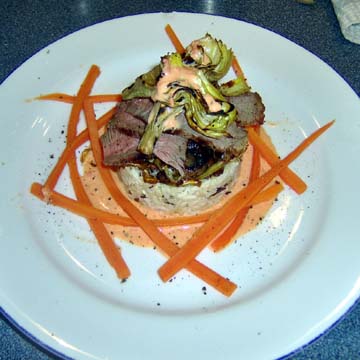
2. grilled beef with garlic roasted artichoke hearts, wild rice, steamed carrots and roasted red bell pepper sauce
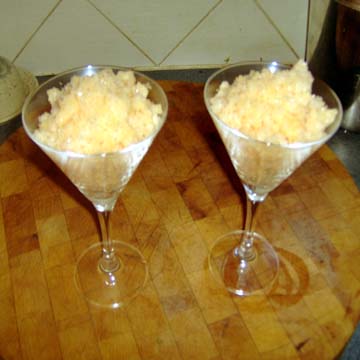
3. cantaloupe granita
As for process, one of the highlights for me was successfully making a puff pastry from scratch for the pot pie. And the roasted red pepper sauce was luxurious, I did a blender mayo with one egg yolk and some olive oil, adding an equal amount of pureed pepper.

we have an electric oven but a portable butane grill
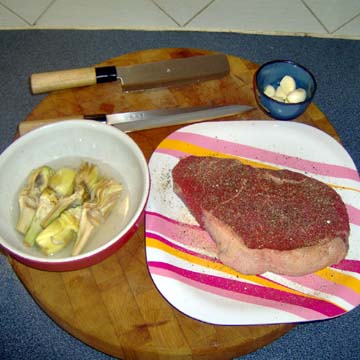
artichokes and beef ready for the grill
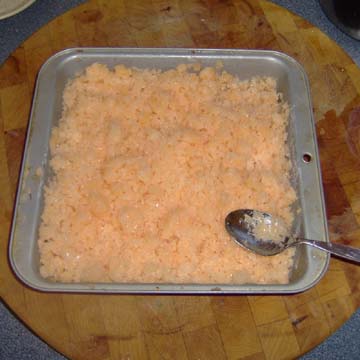
I pureed the cantaloupe adding water, lemon and sugar and made the ice in the pan -
easy, light and delicious.
-
I'm in trouble - where is everyone?
-
You two are the coolest! I love this idea!
As for your ingredients this week -- they're tough. Maybe some type of cantaloupe sorbet? Perhaps with mint or lime or even cilantro as an accent flavor?
Emily
Right on! I would like that sorbet. I am currently looking at Bon Appetit Aug 2001 cantalope granita - the grown up snow cone. Yum.
Those artichokes might be big enough to scoop out the hairy chokes and roast the hearts - research is required.
-
Here is the third of our at home black box challenges:
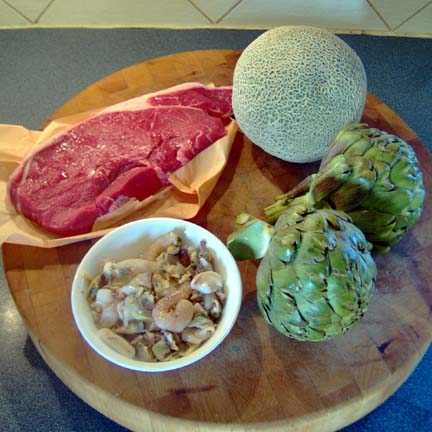
1. beef - boneless top sirloin grilling steak (700 grams)
2. artichokes
3. cantaloupe
4. fresh seafood medley- small bits of squid, octopus, shrimp, mussels, crab, etc.
What should I do?
-
1991 in Halifax, I gave her afternoon squash lessons (as in the racket sport popular in colonies of England, like indoor tennis) and offered to make dinner afterwards. I had stashed a 1.5 L white wine, celery and 2 lbs of mussels in my scary student fridge. It all worked out very well.
-
-
I recently had a four-pack of small but fresh lamb loin chops which needed to be frozen or eaten. Since it was just me for dinner and just for fun I did each one differently:
1. toaster oven (set on broil, electric heat from above)
2. barbecue (actually a Weber gas grill)
3. pan fry (copper pan, bit of olive oil)
4. deep fry (peanut oil, used once for potatoes)
The cuts were all very similar - probably neighbors in the beast's torso - some bone, fat, sinew and tender red meat.
From best to worst, the results were:
2. barbecue: the Weber was best for all the senses
1. toaster oven: good browning and flavour
3. pan fry: ok taste, dry brown "rind" not so good
4. deep fry: a distant forth - all the moisture was vaporized on submersion in oil leaving a gray chewy meat lacking that distinctive lamb flavor.
I don't imagine these finding are much of a surprise. I tend to go for flavor over texture when buying lamb, when I don't want to pay a fortune to get both. A crown rack has very little over a properly prepared shank or shoulder roast.
-
Could anybody explain why steakhouses will either choose to grill or broil their steaks? Does broiling allow for a closer contact with direct heat that allows charring (as it seems to be the case with Peter Luger) while maintaining a rare center?
In my mind, if your grill or broiler has sufficient BTUs, then heat from above should not be different from heat from below in forming a good crust. Steak gurus and grill/broiler masters, what are your thoughts on this subject?
For me grilling tastes and looks better, but I don't know why.



The 100 Mile Diet
in Food Media & Arts
Posted
Just for fun I fired up Google Earth and I drew a 100 mile radius from Central Park NYC.
You are right, it doesn't look good. You barely get to the SW corner of Massachusetts, and heading the other way hardly looks like "the breadbasket of America". Going east out to sea might still get you some nice fish.
Incidentally, the authors claim to have done a 100 mile meal in NYC (although I don't know the details) as well as in some other "extreme" locations.
I'll bet it was not that long ago when just about everybody ate a 100 mile diet out of pure necessity.